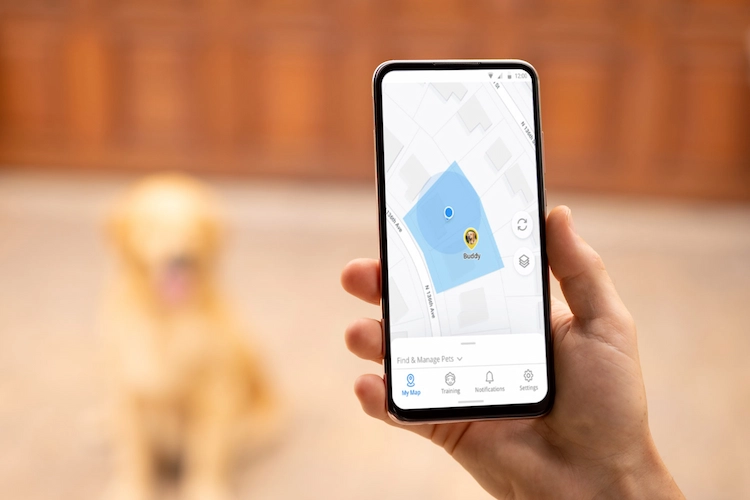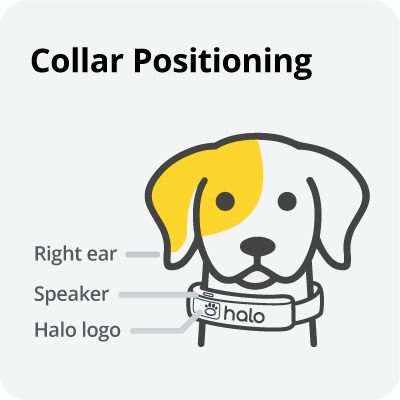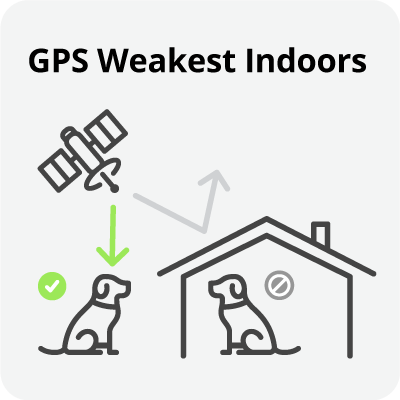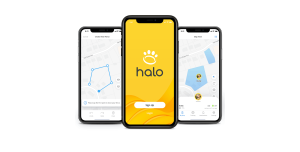
The Halo system uses patented, industry-leading GPS technology to monitor your dog’s location and keep them safe. It is important to understand how Halo’s GPS works so you and your dog can get the most out of your Halo Collar.
Read below to learn some tips and tricks for getting the best results from your Halo’s GPS.

1. Get to know your GPS
Your Halo Collar always knows your dog’s exact location because it is constantly listening to dozens of satellites orbiting the earth. This process does not involve your phone or your Halo Collar app. This location is what the collar uses to enforce fence boundaries and is always up-to-date.
Your collar also sends location updates and event alerts to your phone as soon as possible after they occur. Your collar can use any of three different types of network connections to communicate with your phone: Wi-Fi, Bluetooth, or cellular.
The only difference between network connections is the speed at which location updates get delivered to your app. Bluetooth connections allow for the fastest communication, and will update your dog’s real-time location in the app within one second. Bluetooth works when your phone’s Bluetooth is enabled and your collar is within 50 to 100 feet of your phone.
Your collar will also constantly try to connect to your Halo app via Wi-Fi or cellular data. When there is no Bluetooth connection, and only a Wi-Fi or cellular connection, your collar will send location updates to your app every few seconds. You can request your collar’s current location at any time by hitting the Refresh button on the map.
Remember – your collar knows your dog’s location at all times, regardless of where the Pet Pin is showing up in your app. No matter which connection your collar is using to communicate with your phone – and even if it’s not connected at all – your Halo Collar is ALWAYS protecting your dog in real-time.
2. Position your collar for strongest GPS signal

Positioning the Halo Collar properly on your dog’s neck will allow for the strongest possible GPS signal.
To acquire the best GPS signal strength, position the Halo Collar with the speaker facing toward your dog’s right ear. The word “Halo” on the protective case should be right-side up and under your dog’s chin.
Make sure both contact tips are touching your dog’s skin; otherwise, your dog will not feel Static or Vibration feedback. When your collar is fitted properly to your dog, you should be able to fit two fingers between the collar and your dog’s neck. The collar should fit tightly and should be snug so that it does not rotate or slide on your dog’s neck. Your dog must be able to swallow food and water normally. You should observe your dog’s behavior to verify that the collar is not too tight.
Click here for detailed instructions on adjusting your Halo Collar strap.
3. Charge your collar daily while connected to Wi-Fi
You should get into the habit of charging your collar in a location with a good Wi-Fi connection whenever your dog is not wearing it. Ideally, this location would be near a window – especially if you don’t use your collar every day.
Your collar will automatically download performance updates and retrieve new satellite position data while it’s plugged in and connected to the internet. This will optimize your collar’s GPS accuracy.
Your collar’s Battery light will blink Green while it is charging. When the collar is fully charged, the Battery light will remain solid Green.
When your collar is plugged in and downloading a Collar Update, the Battery light will blink Red. When the Collar Update is complete, the Battery light will go back to blinking Green (or solid Green if charging is complete).
When your collar is plugged in and downloading Satellite Position Data, the GPS light will turn solid PINK. When the satellite position data update is complete, the GPS light will turn off.
If your collar has been powered off for an extended period of time – or after some Collar Updates – you may receive a “GPS Requires Initialization” notice on your phone. To initialize your collar’s GPS, bring it outside by hand with a clear view of the sky. Wait until the location is accurate on My Map before putting the collar on your dog.
4. GPS is weakest indoors

When you are indoors, your collar’s location may not be displayed accurately on My Map. The roof and walls of your home can block the signal between your collar and the GPS satellites in space. When GPS signal strength is low, the Pet Pin will stop moving and fence preventions become automatically disabled.
Note that your collar works reliably with indoor Halo Beacons because Beacons use Bluetooth to communicate – not GPS.
5. GPS signal strength
You can see your collar’s current GPS signal strength (High, Medium, or Low) on the collar itself (GPS light indicator), as well as in your app on the Pet Card. The signal strength your collar is receiving impacts the feedback your collar will provide to your dog. The higher the signal strength your collar is receiving, the more accurate your dog’s location will be on My Map.

Generally, your collar should be receiving High signal strength while outdoors and – depending on your home’s construction – Low signal strength while indoors.
- Your collar will only provide Fence Preventions for your pup when GPS signal strength is High. When your collar’s GPS light is blinking Blue, signal strength is High.
- When receiving Medium signal strength, your collar will only provide Encouragement Feedback to keep your pup safe; Fence Preventions will be disabled. When your collar’s GPS light is blinking Pink, signal strength is Medium.
- When receiving Low signal strength, all collar feedback will be disabled (not including Beacon Feedback). Low signal strength will be indicated by a GPS light that is not lit up.
If your GPS signal strength is High or Medium while indoors, and your dog’s Pet Pin position is inaccurate, you have a few options:
- Adjust your signal-level settings from My Collars > Advanced Settings. You can do this to ensure that your collar only provides Fence Preventions while your pup is outdoors.
- Deploy a Halo Beacon as an Ignore Fences Beacon in the area of your home with High/Medium signal strength. This will ensure that your pup does not receive any Fence Feedback when they are within range of that Beacon.
- Manually disable fence feedback when your dog comes indoors (but remember to turn it back on when you let your dog out!)






